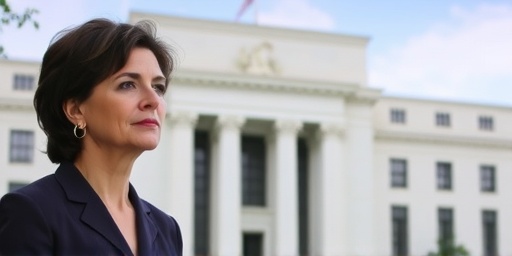In a recent speech that has economists and investors on edge, Federal Reserve Governor Lisa Cook emphasized the central bank’s unwavering commitment to combating inflation, which continues to hover above the 2% target primarily due to the lingering effects of tariffs. Speaking at an economic forum in Washington, D.C., Cook noted that while short-term inflationary pressures persist, long-term inflation expectations remain anchored, providing a measure of stability in an otherwise uncertain economic landscape.
This statement comes at a critical juncture for the U.S. economy, as the Federal Reserve navigates the delicate balance between fostering growth and achieving price stability. With consumer prices rising at a pace that outstrips the Fed’s preferred level, policymakers are signaling that monetary policy adjustments could be on the horizon to address these challenges.
Lisa Cook Details Tariff-Driven Inflation Surge
Federal Reserve Governor Lisa Cook, a key figure in the Fed’s Board of Governors known for her expertise in labor economics and monetary policy, delivered pointed remarks on how tariffs are exacerbating inflation. In her address, she highlighted that recent trade policies, including heightened tariffs on imports from major trading partners like China and the European Union, have directly contributed to elevated costs for businesses and consumers alike.
“Tariffs act as a tax on imports, which inevitably filters through to higher prices for everyday goods,” Cook stated. According to data from the Bureau of Labor Statistics, the Consumer Price Index (CPI) for all urban consumers increased by 3.2% year-over-year in the latest report, a figure well above the Federal Reserve’s 2% target for price stability. Core inflation, which excludes volatile food and energy prices, stood at 3.5%, underscoring the broad-based nature of these pressures.
The impact of tariffs is particularly evident in sectors like manufacturing and retail. For instance, duties on steel and aluminum imports imposed during the Trump administration, and partially retained under subsequent policies, have raised production costs for automakers and appliance manufacturers. A report from the Peterson Institute for International Economics estimates that these tariffs have added approximately 0.5 percentage points to the overall inflation rate since 2018. Cook’s comments align with this analysis, suggesting that without policy reversals, these effects could prolong the fight against inflation.
Economists point to specific examples: the price of washing machines jumped 12% following tariff implementations in 2018, and similar spikes have been observed in electronics and apparel. As global supply chains remain disrupted, the Federal Reserve is closely monitoring how these tariff-induced costs interact with other inflationary drivers, such as wage growth and supply shortages.
Stable Long-Term Expectations Bolster Fed’s Strategy
Despite the immediate concerns over inflation, Governor Cook reassured markets that long-term inflation expectations are holding firm, a crucial factor in the Federal Reserve’s monetary policy framework. Measures from the University of Michigan’s consumer survey and the Cleveland Fed’s inflation expectations model show one-year expectations at around 3.1%, but five- to ten-year forecasts remain anchored near 2.3%, close to the price stability goal.
This stability is vital because unanchored expectations can lead to a wage-price spiral, where workers demand higher pay to keep up with rising costs, further fueling inflation. Cook emphasized that the Federal Reserve’s track record of data-driven decisions has helped maintain this anchor. “Our monetary policy has been effective in keeping long-term expectations stable, even as we address near-term deviations,” she said.
Historical context supports this view. During the 1970s stagflation era, inflation expectations became unmoored, leading to double-digit price increases. In contrast, post-2008 financial crisis policies, including forward guidance and quantitative easing, have instilled confidence in the Fed’s ability to achieve price stability. Recent surveys by the New York Fed indicate that professional forecasters expect inflation to moderate to 2.5% by the end of 2024, assuming no major shocks.
However, Cook cautioned that vigilance is required. With geopolitical tensions potentially leading to new tariffs or trade barriers, the Federal Reserve must remain proactive in its monetary policy to prevent any erosion of these stable expectations.
Federal Reserve’s Monetary Policy Stance Amid Tariff Challenges
The Federal Reserve’s monetary policy remains laser-focused on dual mandates of maximum employment and price stability, but the current inflationary environment dominated by tariffs has prompted a cautious approach to interest rate decisions. At the most recent Federal Open Market Committee (FOMC) meeting, the benchmark federal funds rate was held steady at 5.25% to 5.50%, reflecting the bank’s desire to assess incoming data before further hikes or potential cuts.
Cook’s remarks underscore the Fed’s strategy: a patient yet resolute stance. “We will continue to use our tools to ensure that inflation returns sustainably to our 2% target,” she affirmed. This includes close scrutiny of non-tariff factors like housing costs, which account for nearly a third of the CPI basket and have seen rents rise 8.2% annually.
Monetary policy tools at the Fed’s disposal include adjusting the federal funds rate, which influences borrowing costs across the economy. Higher rates have already cooled demand, with mortgage rates topping 7% and corporate borrowing costs increasing, slowing business investments. A Federal Reserve study released last month found that tariff effects have offset some of these cooling measures, adding complexity to policy calibration.
Market participants are parsing these signals carefully. Bond yields have ticked up slightly following Cook’s speech, with the 10-year Treasury note reaching 4.2%. Stock markets, however, showed mixed reactions, with the S&P 500 dipping 0.5% as investors weigh the prospects of prolonged higher rates against resilient corporate earnings.
- Key Monetary Policy Indicators: Unemployment rate at 3.8%, GDP growth projected at 2.1% for Q4.
- Tariff Mitigation Efforts: Potential for targeted exemptions or negotiations in ongoing trade talks.
- Fed Projections: Median inflation forecast at 2.6% for 2024, per the latest dot plot.
Economic Implications and Expert Reactions to Fed’s Inflation Outlook
The Federal Reserve’s vigilance on inflation has ripple effects across the economy, influencing everything from consumer spending to international trade dynamics. Experts reacting to Cook’s statements highlight both opportunities and risks. Dr. Elena Ramirez, chief economist at the Brookings Institution, noted, “Tariffs are a double-edged sword—protecting domestic industries but inflating costs that monetary policy must counteract.”
Consumer impacts are stark: households are facing higher grocery bills, with food prices up 5.1% year-over-year, partly due to tariff-related agricultural input costs. Businesses, meanwhile, are grappling with squeezed margins; a survey by the National Association of Manufacturers revealed that 65% of respondents cited tariffs as a top concern for profitability.
On the global stage, the European Central Bank and Bank of Japan are watching the U.S. Federal Reserve closely, as tariff policies could spill over into international inflation. The IMF’s latest World Economic Outlook projects global inflation to ease to 5.9% in 2023 but warns of trade fragmentation risks.
Domestic political angles add layers: with midterm elections approaching, debates over tariff reductions or expansions could influence the Federal Reserve’s path. President Biden’s administration has signaled intentions to review certain tariffs, potentially easing some pressures if negotiations succeed.
Wall Street analysts, such as those from Goldman Sachs, predict that if inflation persists above 3%, the Fed may implement another 25-basis-point hike in early 2024. Conversely, signs of cooling— like softening job growth—could pave the way for rate cuts, boosting markets.
Prospects for Achieving Price Stability in a Tariff-Laden Economy
Looking ahead, the Federal Reserve’s path to price stability will hinge on a multifaceted approach that addresses tariffs alongside broader economic trends. Governor Cook’s optimism about stable long-term expectations suggests that monetary policy can guide inflation back to target without drastic measures, but external factors remain unpredictable.
Potential next steps include enhanced communication through FOMC statements and speeches, providing markets with clearer guidance. The Fed is also exploring ways to incorporate trade policy into its models, as traditional Phillips Curve analyses may understate tariff effects.
For consumers and businesses, this means preparing for sustained higher prices in the near term. Strategies like diversifying supply chains or investing in domestic production could mitigate tariff impacts, aligning with the Fed’s goal of resilient growth.
Ultimately, achieving price stability will require coordination between monetary policy and fiscal measures. As Cook implied, the Federal Reserve stands ready to adapt, ensuring that inflation’s grip loosens without derailing the economic recovery. Investors and policymakers alike will be watching the December FOMC meeting for fresh insights, where updated economic projections could signal shifts in the bank’s stance.
In this environment, the interplay between tariffs and inflation continues to test the Federal Reserve’s resolve, but the institution’s data-centric approach offers hope for a balanced resolution.









